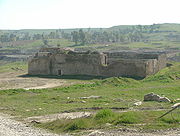
Dair Mar Elia (Saint Elijah's Monastery)
Encyclopedia

Christian
A Christian is a person who adheres to Christianity, an Abrahamic, monotheistic religion based on the life and teachings of Jesus of Nazareth as recorded in the Canonical gospels and the letters of the New Testament...
monastery
Monastery
Monastery denotes the building, or complex of buildings, that houses a room reserved for prayer as well as the domestic quarters and workplace of monastics, whether monks or nuns, and whether living in community or alone .Monasteries may vary greatly in size – a small dwelling accommodating only...
, the oldest in Iraq
Iraq
Iraq ; officially the Republic of Iraq is a country in Western Asia spanning most of the northwestern end of the Zagros mountain range, the eastern part of the Syrian Desert and the northern part of the Arabian Desert....
, dating from the 6th century. It is located in the Ninawa Governorate
Ninawa Governorate
Ninawa is a governorate in northern Iraq, and the Arabic name for the biblical city of Nineveh in Assyria. It has an area of and an estimated population of 2,453,000 people in 2003. Its chief city and provincial capital is Mosul, which lies across the Tigris river from the ruins of ancient...
just south of Mosul
Mosul
Mosul , is a city in northern Iraq and the capital of the Ninawa Governorate, some northwest of Baghdad. The original city stands on the west bank of the Tigris River, opposite the ancient Assyrian city of Nineveh on the east bank, but the metropolitan area has now grown to encompass substantial...
.
The monastery was founded around 595 AD by Mar Elia, an Assyrian
Assyrian people
The Assyrian people are a distinct ethnic group whose origins lie in ancient Mesopotamia...
monk who had previously studied at al-Hirah
Al-Hirah
Al Hīra was an ancient city located south of al-Kufah in south-central Iraq.- Middle Ages:Al Hīra was a significant city in pre-Islamic Arab history. Originally a military encampment, in the 5th and 6th centuries CE it became the capital of the Lakhmids.The Arabs were migrating into the Near East...
and later in the great monastery at Ezla mountain in Turkey
Turkey
Turkey , known officially as the Republic of Turkey , is a Eurasian country located in Western Asia and in East Thrace in Southeastern Europe...
. It was later claimed by the Chaldeans
Chaldean Christians
Chaldean Christians are ethnic Assyrian adherents of the Chaldean Catholic Church, most of whom entered communion with the Catholic Church from the Church of the East, which was already Catholic, but most wanted to stray away from the Catholic Church, causing the split in the 17th and 18th...
. The monastery was the center of the regional Christian community and for centuries thousands of Christians would visit the monastery to observe the Mar Elia Holiday, which falls on the last Wednesday of November.
The monastery was renovated in the 17th century by Hurmizd Alqushnaya. In 1743, the Persian leader Tahmaz Nadir Shah
Nader Shah
Nāder Shāh Afshār ruled as Shah of Iran and was the founder of the Afsharid dynasty. Because of his military genius, some historians have described him as the Napoleon of Persia or the Second Alexander...
ordered the destruction of its property and the death of the monks who dwelt there. The monastery laid in ruins until the beginning of 20th century, when some restoration was completed on a few halls and rooms. During the First World War, Dair Mar Elia was a place of refuge which lead to the rebuilding of part of the site. The structure, along with its neighboring reservoir and natural mineral water springs, were cared for by the Chaldean Church, and Christian pilgrims
Christian pilgrimage
Christian pilgrimage was first made to sites connected with the ministry of Jesus. Surviving descriptions of Christian pilgrimages to the Holy Land and Jerusalem date from the 4th century, when pilgrimage was encouraged by church fathers like Saint Jerome and established by Helena, the mother of...
continued to visit the ruins.
After the Iraq War, the site lay within Forward Operating Base Marez and American forces began to visit and later tend for the site. After being vacated by the retreating Iraqi Republican Guard
Iraqi Republican Guard
The Iraqi Republican Guard was a branch of the Iraqi military during the presidency of Saddam Hussein. It later became the Republican Guard Corps, and then the Republican Guard Forces Command with its expansion into two corps....
, the 101st Airborne Division
101st Airborne Division
The 101st Airborne Division—the "Screaming Eagles"—is a U.S. Army modular light infantry division trained for air assault operations. During World War II, it was renowned for its role in Operation Overlord, the D-Day landings on 6 June 1944, in Normandy, France, Operation Market Garden, the...
took charge of the area. Later, the 94th Engineer Battalion made a topographical survey of the monastery. Dair Mar Elia has been fenced off to protect the site and military chaplains guide soldiers on tours of the ruins. These actions were part of a long-term effort to help local Iraqis become more aware of the site as well as to promote the awareness for historic preservation
Historic preservation
Historic preservation is an endeavor that seeks to preserve, conserve and protect buildings, objects, landscapes or other artifacts of historical significance...
.
In May 2008, Iraqi archaeologists were able to visit the areas for the first time since before the Second Gulf War
Second Gulf War
Different armed conflicts in the Persian Gulf region have been called the Second Gulf War:*Gulf War , a war between Iraq and a coalition of nations led by the United States...
. While portions needed protection from the elements, other areas that were largely unexcavated had been protected from looters.

